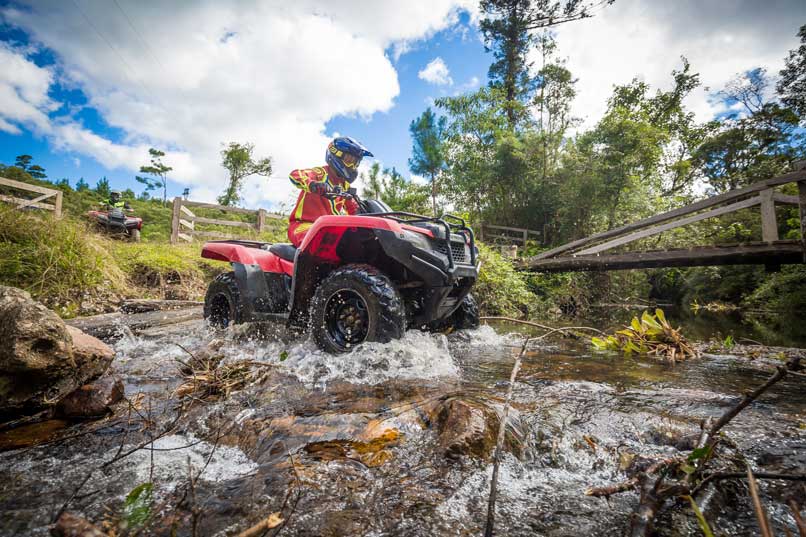4 Tips to Ensure Your Safety When Riding an ATV
Hoosiers love their all-terrain vehicles (ATVs), but it’s important to take the safety precautions associated with ATVs as seriously as you would if you were riding a motorcycle or driving a car. Indiana Conservation Officers from the Department of National Resources (DNR) are concerned about the sudden increase in ATV fatalities. In 2016, there were […]

July 26, 2017

Hoosiers love their all-terrain vehicles (ATVs), but it’s important to take the safety precautions associated with ATVs as seriously as you would if you were riding a motorcycle or driving a car.
Indiana Conservation Officers from the Department of National Resources (DNR) are concerned about the sudden increase in ATV fatalities. In 2016, there were 23 fatal ATV crashes, but in 2015, there were only 16.
As of April, there were already 2 deadly ATV crashes in Indiana in 2017. To help address this rise in fatalities, Governor Eric Holcomb signed a law requiring anyone under 18 to wear a helmet while riding or operating any off-road vehicle as of July 1, 2017.
But there are other safety measures you can take to make sure that your ride on an ATV doesn’t end in tragedy.
1. Wear a Helmet

Only minors are required by law to wear a helmet when riding or operating an ATV, but no matter how old you are, wearing a helmet is a good idea. Beware of novelty helmets—you want your safety equipment not to be a fashion statement, but to actually protect you. Make sure whatever helmet you purchase is compliant with Department of Transportation standards.
A helmet can muffle wind noise and not only help you hear better, but actually preserve your hearing for years to come. Helmets protect your head in the event of a crash, but they also protect your eyes from wind and debris. Brightly colored helmets are also great for increasing your visibility to other drivers.
ATV helmets are different than motorcycle helmets, although a motorcycle helmet will typically work alright if you’re not a frequent or aggressive rider. If you are an aggressive rider, you’re probably better off with an off-road or motocross helmet. These helmets provide ventilation around the top, nose, mouth, and sides and a flip-up visor that shields your face.
Remember, helmets should typically be replaced every five years or immediately following an impact.
2. Wear All of the Gear

Helmets are great, but the rest of your standard safety gear is important, too. If you’re wearing an open-faced helmet, goggles are a must for keeping dust and debris out of your eyes. To ensure minimum protection, you should at least wear a helmet, goggles if necessary, a long-sleeve sweatshirt, sturdy jeans, boots that come over the ankles, and well-made gloves that don’t inhibit your ability to grip.
If you can afford to purchase more protective gear, do so. Outside chest protectors, knee and elbow guards, and motocross-specific pants, gloves, and boots are all helpful items that will protect you in case of an accident.
3. One Rider Per Vehicle on the Right Vehicle

Although ATVs are large, typical models are only built for one person. ATVs don’t have seat belts and are easy to flip, which makes it even more dangerous to have more than one person on a vehicle and add extra weight the vehicle is not built to compensate for. Unless your ATV is specifically equipped for two people, make sure you only ride one person at a time.
Be sure that your vehicle is the right size for you as well. As a general rule, anyone under 16 years old should only ride vehicles with engine power less than 90cc.
It’s also a good idea to inspect your vehicle before you ride. Check for damage or normal wear-and-tear. If you find anything that’s cause for concern, avoid riding until your vehicle is fixed.
4. Ride with Friends on Designated Trails, and Ride Sober

Although you can’t share your ATV with a friend, riding with friends on multiple ATVs is not only fun, but it’s a great way to ensure your safety. If anything happens on the ride, you’ll have someone around to help you or go get help if it’s an emergency.
It’s important also to ride on designated trails. This is for other people’s safety as much as your own. You don’t want to accidentally crash into a hiker because you’re not where you’re supposed to be. Riding on designated trails also reduces your risk of getting into an accident or damaging your vehicle because of an unknown obstacle on the path that may not be hazardous to someone who’s riding a bike or taking a walk.
And just like with driving a car or riding a motorcycle, make sure you don’t operate your ATV while intoxicated. Ride first, party later.
Help from an Indiana Accident Attorney
Even with new laws in place and safety tips available to the public, accidents still occur on ATVs. If you’ve been injured on an ATV, Hensley Legal Group can help. Call us today or contact us online for a free consultation.
Available 24/7
Free Case Review
You won’t pay any fees until we win your case.
It’s easy - you can: